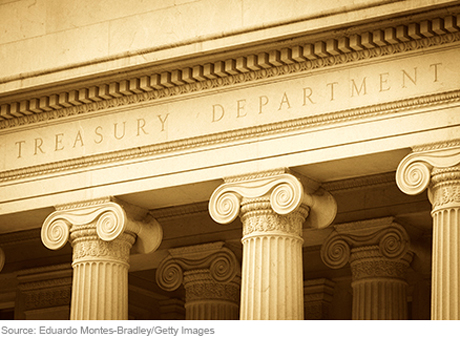A New Reserves Regime? COVID‑19 and the Federal Reserve Balance Sheet
Aggregate reserves declined from nearly $3 trillion in August 2014 to $1.4 trillion in mid-September 2019, as the Federal Reserve normalized its balance sheet. This decline came to a halt in September 2019 when the Federal Reserve responded to turmoil in short-term money markets, with reserves fluctuating around $1.6 trillion in the early months of 2020. Then, in response to the COVID-19 pandemic, the Federal Reserve dramatically expanded its balance sheet, both directly, through outright purchases and repurchase agreements, and indirectly, as a consequence of the facilities to support market functioning and the flow of credit to the real economy. In this post, we characterize the increase in reserves between March and June 2020, describing changes to the distribution and concentration of reserves.
How the Fed Managed the Treasury Yield Curve in the 1940s
The coronavirus pandemic has prompted the Federal Reserve to pledge to purchase Treasury securities and agency mortgage-backed securities in the amount needed to support the smooth market functioning and effective transmission of monetary policy to the economy. But some market participants have questioned whether something more might not be required, including possibly some form of direct yield curve control. In the first half of the 1940s the Federal Open Market Committee (FOMC) sought to manage the level and shape of the Treasury yield curve. In this post, we examine what can be learned from the FOMC’s efforts of seventy-five years ago.
From Policy Rates to Market Rates—Untangling the U.S. Dollar Funding Market

How do changes in the rate that the Federal Reserve pays on reserves held by depository institutions affect rates in money markets in which the Fed does not participate? Through which channels do changes in the so-called administered rates reach rates in onshore and offshore U.S. dollar money markets? In this post, we answer these questions with the help of an interactive map that guides us through the web of interconnected relationships between the Fed, key market players, and the various instruments in the U.S. dollar funding market, highlighting the linkages across the short-term financial products that form this market.
Selected Deposits and the OBFR
In this Liberty Street Economics post, Cipriani and coauthors discuss changes in the calculation of the Overnight Bank Funding Rate (OBFR), the reason for including selected deposits, and the likely impact of the change on the OBFR’s published value.
Assessing the Price Impact of Treasury Market Workups

The price impact of a trade derives largely from its informational content. The “workup” mechanism, a trading protocol used in the U.S. Treasury securities market, is designed to mitigate the instantaneous price impact of a trade by allowing market participants to trade additional quantities of a security after a buyer and seller first agree on its price. Nevertheless, workup trades are not necessarily free of information. In this post, we assess the role of workups in price discovery, following our recent paper in the Review of Asset Pricing Studies (an earlier version of which was released as a New York Fed staff report).
Size Is Not All: Distribution of Bank Reserves and Fed Funds Dynamics

As a consequence of the Federal Reserve’s large-scale asset purchases from 2008-14, banks’ reserve balances at the Fed have increased dramatically, rising from $10 billion in March 2008 to more than $2 trillion currently. In that new environment of abundant reserves, the FOMC put in place a framework for controlling the fed funds rate, using the interest rate that it offered to banks and a different, lower interest rate that it offered to non-banks (and banks). Now that the Fed has begun to gradually reduce its asset holdings, aggregate reserves are shrinking as well, and an important question becomes: How does a change in the level of aggregate reserves affect trading in the fed funds market? In our recent paper, we show that the answer depends not just on the aggregate size of reserve balances, as is sometimes assumed, but also on how reserves are distributed among banks. In particular, we show that a measure of the typical trade in the market known as the effective fed funds rate (EFFR) could rise above the rate paid on banks’ reserve balances if reserves remain heavily concentrated at just a few banks.
Restoring Economic Growth in Puerto Rico: Introduction to the Series
The difficult economic and financial issues facing the Commonwealth of Puerto Rico have remained very much in the news since our post on options for addressing its fiscal problems appeared last fall. That post was itself a follow-up on a series of analyses, starting with a 2012 report that detailed the economic challenges facing the Commonwealth. In 2014, we extended that analysis with an update where we focused more closely on the fiscal challenges facing the Island. As the problems deepened, we have continued to examine important related subjects ranging from positive revisions in employment data, to the understanding emigration, and to considering how the Commonwealth’s public debts stack up. In most of this work, we have focused on how policymakers could help to address the immediate issues facing the Island and its people. The U.S. Congress and the Obama Administration took action in June to provide a framework to help address Puerto Rico’s fiscal crisis. But much remains to be done to address these ongoing problems, which represent a significant impediment to economic growth in the short run. It also seems important to revisit the question of the prospects for reviving longer-run growth in the Commonwealth. These concerns were underscored by projections published by the International Monetary Fund (IMF) in the April edition of the World Economic Outlook that forecast Puerto Rico’s real GDP and population to decline through 2021.
How Have High Reserves and New Policy Tools Reshaped the Fed Funds Market?
Gara Afonso and Sammuel Stern Over the last decade, the federal funds market has evolved to accommodate new policy tools such as interest on reserves and the overnight reverse repo facility. Trading motives have also responded to the expansion in aggregate reserves as the result of large-scale asset purchases. These changes have affected market participants […]
Hey, Economist! Why—and When—Did the Treasury Embrace Regular and Predictable Issuance?

Few people know the Treasury market from as many angles as Ken Garbade, a senior vice president in the Money and Payments Studies area of the New York Fed’s Research Group. Ken taught financial markets at NYU’s graduate school of business for many years before heading to Wall Street to assume a position in the research department of the primary dealer division of Bankers Trust Company. At Bankers, Ken conducted relative-value research on the Treasury market, assessing how return varies relative to risk for particular Treasury securities. For a time, he also traded single-payment Treasury obligations known as STRIPS—although not especially successfully, he notes.















 RSS Feed
RSS Feed Follow Liberty Street Economics
Follow Liberty Street Economics